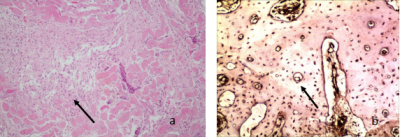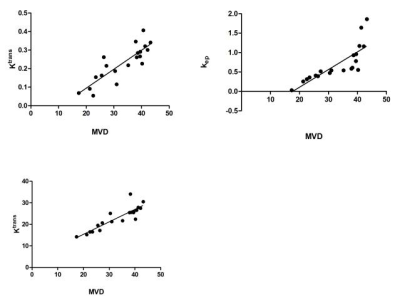2643
Dynamic Contrast-enhanced MR imaging of rabbit VX2 bone tumor: Model Selection, repeatability and ValidationWei Gong1 and Yunfei Zha1
1Renmin Hospital of Wuhan University, Wu han, China
Synopsis
To compare the repeatability and availability of the quantitative parameters for dynamic contrast-enhanced MR imaging that is based on the Reference-Region model and Tofts model with the microcirculation perfusion and permeability characteristics in rabbit VX2 bone tumor.
Purpose
To compare the repeatability and availability of the quantitative parameters for dynamic contrast-enhanced MR imaging that is based on the Reference-Region model and Tofts model with the microcirculation perfusion and permeability characteristics in rabbit VX2 bone tumor.Methods
20 rabbit VX2 bone tumor models were scanned by DCE-MRI.Build the reference region(R-R) model[1] and the Tofts model[2] on the femoral artery of the affected side, the parameters including microvascular permeability transfer constant(Ktrans) and the microvascular permeability reflux constant(kep) were derived. Pharmacokinetic parameters were measured twice to determine the reproducibility by two experts with more than 10 years of MR diagnostic experience. The specimens from 20 rabbit VX2 bone tumor were collected for histologic validation. Repeatability was assessed by using the coefficientof variation of Bland-Altman analysis. Correlation with histologic findings were evaluated with the Pearson correlation coefficient.Results
The Ktrans value and kep value in the Tofts model were positively correlated with the MVD( r=0.853,0.805, respectively, P<0.01). The Ktrans value in the Reference-Region model was positively correlated with the MVD(r=0.882,P=0.002), the repeatability for Ktrans value was the best in the two models(ICC>0.6, P<0.05). The ICC for the Ktrans value in Reference-Region model was maximum(ICC=0.81), the repeatability for the kep value in Tofts model was poor(ICC=0.39, and that the coefficient of variation for the Ktrans value in Reference-Region model was smaller(r=0.07).Conclusion
The Ktrans value of DCE-MRI based on the Reference-Region model and the Tofts model could both estimate the microcirculation perfusion and permeability characteristics in rabbit VX2 bone tumor. The repeatability for Ktrans value in the Reference-Region model was better than that in the Tofts model,in the low time resolving power imaging.Acknowledgements
I want to take this chance to thanks to my tutor----Yunfei Zha,. In the process of composing this paper, he gives me many academic and constructive advices, and helps me to correct my paper. Except these, he also gave me the opportunity to do my teaching practice.References
[1]Heisen M, Fan X, Buurman J, et al. The use of a reference tissue arterial input function with low-temporal-resolution DCE-MRI data[J]. Phys Med Biol,2010,55(16):4871-4883.
[2] Yankeelov T E, Luci J J, Lepage M, et al. Quantitative pharmacokinetic analysis of DCE-MRI data without an arterial input function: a reference region model[J]. Magn Reson Imaging,2005,23(4):519-529.
Figures

Fig 1a The tibia of rabbits VX2 bone tumor model of DCE-MRI enhancement scanning Tofts model of region of interest selection, the red circle as the efferent blood vessel (femoral artery) and a yellow circle for region of interest. figure 1b for pseudo color pictures of Tofts model. figure 1c for the time-signal intensity curves

Fig 2a The tibia of rabbits VX2 bone tumor model of DCE-MRI enhancement scan RR model of region of interest selection, the red circle as reference region (gastrocnemius) and a yellow circle for region of interest. Fig 2b The pseudo color pictures of RR model. Fig 2c for the time-signal intensity curves.

HE staining and MVD distribution of in the VX2 rabbit bone tumor. Fig3a the black arrow refers to tumor cell(S-P40×). Fig 3b for the expression of MVD(S-P.100×).

Figure 4A,B Tofts model parameters Ktrans values, kep values and MVD values were positive correlation. Figure4C for the R-R model parameters Ktrans value and MVD value was positively correlated